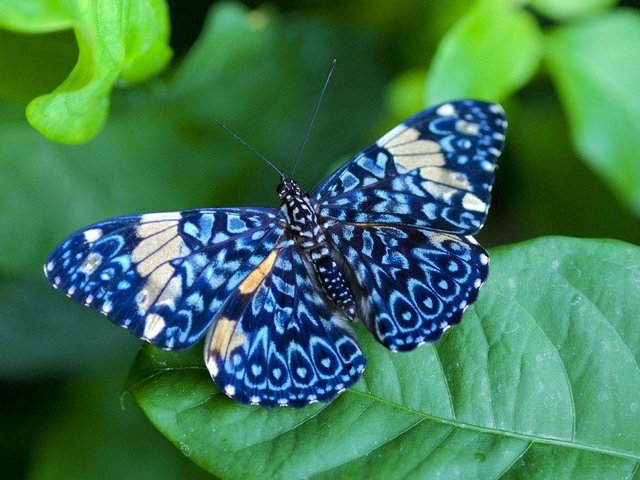 The general public's confusion about butterflies of the Morpho genus is due to the fact that their dazzling wings are predominantly blue. A common feature in the 29 species and 147 subspecies described to date, all found in the tropical forests of Central and South America, distributed throughout Brazil, Costa Rica, Guyana and Venezuela and Mexico.
The general public's confusion about butterflies of the Morpho genus is due to the fact that their dazzling wings are predominantly blue. A common feature in the 29 species and 147 subspecies described to date, all found in the tropical forests of Central and South America, distributed throughout Brazil, Costa Rica, Guyana and Venezuela and Mexico.
The bright blue (sometimes green) metallic wings are not the result of pigmentation, but caused by the refraction of light in tiny transparent scales, inserted in the wings of the butterfly. The microscopic scales that make up its wings repeatedly reflect incident light into several successive layers, creating observed color effects. The blade-like structure of the wings of these butterflies is so peculiar that it has been studied as a model for tissue development, dye-free inks and anti-counterfeiting technology for use in money notes.
But the microscopic scales are present only in the upper part of the wings. The lower part is predominantly brown and decorated with ocelli, circular regions of dark pigments that form patterns that resemble, a kind of mimicry.
Another characteristic of the wings of these butterflies is the large size in relation to the body. Morpho butterflies can have a wingspan of just over 7cm to an impressive 20cm (a school ruler).
Such large wings result in a slow, bouncy flight pattern but have a beneficial effect on the animal: the blue top "blinks" as it alternates with the dark underside. This makes it difficult to be accompanied by birds in the air. If found, it closes its wings, exposing the ocelli: the "eyes" or will deceive the potential predator making it resemble an inedible animal, greater or even dangerous; Or it will draw the predator's attention away from the most vulnerable areas of his body, allowing him to escape.
Although the wings of the Morpho genus are predominantly blue, there are a number of other species endowed with wings of other colors: oranges-roasted, fawn or dark brown for M. hecuba and M. telemachus; White, such as M. catenarius, M. laertes and the very rare M. sulkowskyi, which also exhibits purple and iridescent green.
In Brazil, the most common species are Morpho rhetenor and Morpho anaxibia. The first stands out as the brightest among those with metallic blues. M. anaxibia is an endemic species of the country, commonly called blue-silk, corcovado (very common in Central-South and Southeast) or azulão.
They are butterflies of daily habits: males spend their mornings patrolling along courses and rivers. They are territorial and will persecute any rival. But it is common to be alone, except in the mating season.
The Morpho caterpillars, like the other butterflies, go through five larval stages, becoming a chrysalis. A curiosity, of predominantly green coloration, the chrysalis emits a repulsive ultrasonic sound when disturbed, spending all its time, until hatching, hanging from a branch or other structure of the plant. In total, the development cycle lasts 115 days, from egg to adult.
Morpho butterflies are not on the IUCN Red List of Threatened Species. For ICMBio, however, the species Morpho menelaus eberti and Morpho epistrophus nikolajewna, which occur in the Northeastern Forest Zone (Paraíba, Pernambuco and Alagoas), are classified as In Peril due to the loss and degradation of natural habitats.